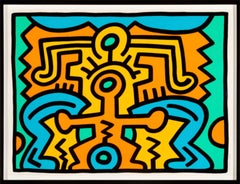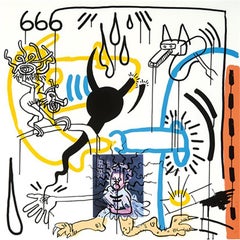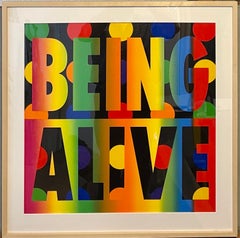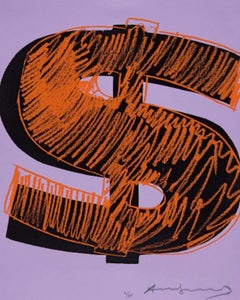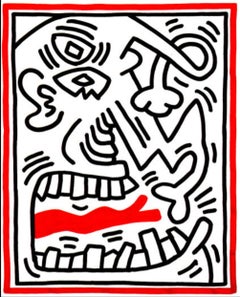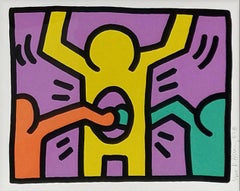Keith Haring Art
Keith Haring began experimenting with his bold, graphic lines and cartoon-inspired figures on the walls of New York City subway stations in the early 1980s. He called them his “laboratory,” places to develop a radical new aesthetic based on an ideology of creating truly democratic public art.
Haring’s paintings, prints and murals address the universal themes of death, love and sex, as well as contemporary issues he experienced personally, like the crack-cocaine and AIDS epidemics. They derive much of their impact from the powerful contrast between these serious subjects and the joyful, vibrant pictographic language he uses to express them, full of dancing figures, babies, barking dogs, hearts and rhythmic lines, as well as references to pop culture.
To make his art even more accessible, in 1986, Haring opened the Pop Shop in Soho. In a foreshadowing of today’s intermingling of art and fashion, the shop sold merchandise and novelty items featuring imagery by Haring and contemporaries like Kenny Scharf and Jean-Michel Basquiat. While his works sometimes included text, for the most part, he chose to communicate through drawing.
“Drawing is still basically the same as it has been since prehistoric times,” Haring once declared. “It lives through magic.”
Find Keith Haring art on 1stDibs today.
1980s Pop Art Keith Haring Art
Screen
1980s Pop Art Keith Haring Art
Screen
1980s Pop Art Keith Haring Art
Screen
1980s Pop Art Keith Haring Art
Screen
1980s Pop Art Keith Haring Art
Screen
1980s Pop Art Keith Haring Art
Screen
1980s Pop Art Keith Haring Art
Screen
1980s Street Art Keith Haring Art
Color, Screen
1980s Pop Art Keith Haring Art
Lithograph
1980s Pop Art Keith Haring Art
Screen
1980s Street Art Keith Haring Art
Lithograph
1980s Street Art Keith Haring Art
Lithograph
1980s Street Art Keith Haring Art
Lithograph
2010s Pop Art Keith Haring Art
Screen
1980s Pop Art Keith Haring Art
Screen
20th Century Pop Art Keith Haring Art
Screen, Paper
1970s Pop Art Keith Haring Art
Screen
1980s Pop Art Keith Haring Art
Screen
20th Century Pop Art Keith Haring Art
Screen, Paper
2010s Pop Art Keith Haring Art
Screen
1980s Pop Art Keith Haring Art
Screen
Late 20th Century Pop Art Keith Haring Art
Screen
1990s Pop Art Keith Haring Art
Screen
2010s Pop Art Keith Haring Art
Paper, Screen
1960s Pop Art Keith Haring Art
Textile, Screen
1980s Pop Art Keith Haring Art
Lithograph
1980s Pop Art Keith Haring Art
Screen
1980s Pop Art Keith Haring Art
Screen
1980s Street Art Keith Haring Art
Lithograph
Keith Haring art for sale on 1stDibs.
Artists Similar to Keith Haring
- 1stDibs ExpertApril 11, 2024Keith Haring worked in a variety of mediums. The legendary Pennsylvania-born artist experimented with painting, sculpture, printmaking, performance, video, murals and more. In 2023, a series of digital drawings Haring made on a personal computer during the late 1980s went to auction. No canvas was off limits, either, as he painted on wood, vast tarps and sheets of metal. Haring was always experimenting, even in his early days as an artist.
When Haring arrived in New York City, he was drawn to subway graffiti and other street art, and was soon drawing with chalk on the black sheets of paper that were affixed to subway panels when there wasn’t a poster advertisement to populate the space.
To make his art even more accessible, in 1986, Haring opened the Pop Shop in Soho. In a foreshadowing of today’s intermingling of art and fashion, the shop sold merchandise and novelty items featuring imagery by Haring and contemporaries like Kenny Scharf and Jean-Michel Basquiat.
Find original Keith Haring art on 1stDibs. - 1stDibs ExpertFebruary 27, 2024The Keith Haring Foundation owns the Keith Haring estate. In 1989, the American artist set up the foundation to guarantee that his philanthropic efforts would continue after his death. Under the foundation's structure, The Keith Haring Studio is the owner of the copyrights to all of Haring's works. Find an assortment of Keith Haring art on 1stDibs.
- Who is Keith Haring?1 Answer1stDibs ExpertMarch 22, 2022Keith Haring was a modern American artist and activist. He began as a street artist creating graffiti-inspired works throughout New York City’s subway system and would later produce public murals in cities all over the world. Haring’s paintings, prints and murals address the universal themes of death, love and sex, as well as contemporary issues he experienced personally, like the crack-cocaine and AIDS epidemics. In 1986, Haring opened a Pop Shop in Manhattan’s Soho neighborhood to sell merchandise bearing his bold, cartoon-inspired designs. On 1stDibs, find a variety of Keith Haring art.
- Where is Keith Haring from?1 Answer1stDibs ExpertMarch 22, 2022Keith Haring is originally from Kutztown, Pennsylvania, although he was born in the nearby city of Reading, Pennsylvania, on May 4, 1958. In 1978, Haring moved to New York City. He continued to live there until he died on February 16, 1990. Find a selection of Keith Haring art on 1stDibs.
- 1stDibs ExpertMarch 25, 2024Keith Haring's art was about a variety of subjects. His paintings, prints and murals addressed themes of death, love and sex, as well as contemporary issues, like drug use and the AIDS epidemic. His work derives much of its impact from the powerful contrast between these serious subjects and the joyful, vibrant pictographic language he used to express them. Haring’s enduring work is full of dancing figures, babies, barking dogs, hearts and rhythmic lines, as well as references to pop culture. On 1stDibs, explore a collection of Keith Haring art.
- What is Keith Haring famous for?1 Answer1stDibs ExpertMarch 22, 2022Keith Haring is famous for producing bold cartoon-style art. You may see his work printed on everything from home décor to coffee mugs to fashion accessories. He gained notoriety for street art in his early days as an artist. Later, Haring’s revered paintings, prints and murals would address the universal themes of death, love and sex, as well as contemporary issues he experienced personally, like the crack-cocaine and AIDS epidemics. On 1stDibs, find a collection of Keith Haring art.
- How do I pronounce Keith Haring?1 Answer1stDibs ExpertMarch 22, 2022To pronounce Keith Haring, say "Keeth HEH-ring." Keith Haring was born on May 4, 1958, in Reading, Pennsylvania, and grew up in nearby Kutztown, Pennsylvania. You'll find a range of Keith Haring art on 1stDibs.
- Where did Keith Haring work?1 Answer1stDibs ExpertMarch 22, 2022In his early days as an artist, Keith Haring worked primarily in New York City, where he created murals on walls and unused advertising boards along Manhattan’s subway system. Once his work gained popularity, he traveled to produce work in Australia, Europe and elsewhere. You'll find a collection of Keith Haring art on 1stDibs.
- When was Keith Haring born?1 Answer1stDibs ExpertMarch 22, 2022Keith Haring was born on May 4, 1958, in Reading, Pennsylvania. After growing up in Kutztown, Pennsylvania, and briefly attending art school in Pittsburgh, Pennsylvania, he moved to New York City, where he made a name for himself creating street art on the subway system. Haring gained an even larger audience in the years that followed, producing public murals that were often commissioned and making art that was frequently informed by political and cultural issues. On 1stDibs, find a selection of Keith Haring art.
- What inspired Keith Haring?1 Answer1stDibs ExpertMarch 22, 2022Keith Haring drew most of his inspiration from graffiti artists and got his start painting subway stations and other locations around New York City. In addition, artists such as Pierre Alechinsky, William Burroughs, Jean Dubuffet, Brion Gysin and Robert Henri influenced his work. On 1stDibs, shop a collection of Keith Haring art.
- Why is Keith Haring important?1 Answer1stDibs ExpertMarch 22, 2022Keith Haring is important primarily because his innovative work, which began as street art on the New York City subway, became widely known during the 1980s and influenced other artists working at the time. Haring was also an activist — his late-career prints and murals addressed contemporary issues he experienced personally, like the crack-cocaine and AIDS epidemics. Haring helped elevate graffiti art and was one of the first artists to begin placing his designs on merchandise sold to the general public through his Pop Shop in New York City. Shop a collection of Keith Haring art on 1stDibs.
- Where did Keith Haring live?1 Answer1stDibs ExpertMarch 22, 2022For most of his life, Keith Haring lived in New York City and died there on February 16, 1990. He grew up in Kutztown, Pennsylvania, and briefly attended an art school in Pittsburgh, Pennsylvania. After he arrived in New York in 1978, he turned the city into a gallery space, creating murals in public areas like subway stations. On 1stDibs, shop a collection of Keith Haring art.
- 1stDibs ExpertMarch 22, 2022The Keith Haring Foundation is a philanthropic organization founded by the artist Keith Haring in 1989. Its mission is to provide funding for nonprofit organizations who offer services and programs for children or conduct research or educational initiatives related to AIDS.
- 1stDibs ExpertFebruary 1, 2024Some facts about Keith Haring include that he began his career by creating street art in New York subway stations, which he referred to as his "laboratory." In 1986, Haring opened the Pop Shop in Manhattan’s Soho neighborhood and began selling merchandise and novelty items featuring imagery by himself and contemporaries like Kenny Scharf and Jean-Michel Basquiat. Also, the world's largest jigsaw puzzle features Haring's artwork and consists of 32,000 pieces. After his death, his estate formed the Keith Haring Foundation to raise awareness about AIDS and fund research into the autoimmune disease. On 1stDibs, explore a wide range of Keith Haring art.
- 1stDibs ExpertApril 5, 2022There are a few tell-tale signs you can look for to determine whether your Keith Haring is real or fake. Authentic Keith Haring artwork features a continuous, unbroken line, a subtle signature, barking dogs and crying babies. There are often fakes and the story of them being a gift to an old boyfriend is often an invalid provenance. Shop a collection of authentic Keith Haring artwork from some of the world’s top art dealers on 1stDibs.
- 1stDibs ExpertMarch 22, 2022For his earlier works of art, Keith Haring found inspiration in graffiti and applied paint or chalk to advertising boards spread across New York City that had not yet been used. Much of Haring’s street art was created in subway stations. As his work became more widely known, Haring was frequently commissioned for public murals and would often paint in oils and acrylics on canvas. He also produced merchandise bearing some of his most famous designs. Shop a selection of Keith Haring art on 1stDibs.
- 1stDibs ExpertMarch 22, 2022You can buy Keith Haring art from a variety of sources. One option is to go through an auction house or reputable art dealer. Some trusted online platforms also sell pieces by Keith Haring. You'll find a collection of expertly vetted Keith Haring art on 1stDibs.
- 1stDibs ExpertApril 5, 2022The Keith Haring Foundation owns international copyright to artwork created by Keith Haring. In 1989, Haring himself established the foundation to ensure that his philanthropic legacy would continue. The Keith Haring Foundation today makes grants to charitable activities in accordance with Haring’s wishes. Shop a selection of Keith Haring pieces from some of the world’s top art dealers on 1stDibs.
- 1stDibs ExpertApril 5, 2022What Keith Haring's figures mean depends on the lines near them. Curves show that a figure is in motion, while short straight lines represent sound. The figures themselves are usually meant to signify various roles in society. On 1stDibs, shop a selection of Keith Haring art.
- 1stDibs ExpertMarch 22, 2022Keith Haring became famous largely through people viewing the street art he created in subway stations and other locations in New York City. Throughout the 1980s, he was commissioned to produce art in dozens of cities all over the world and showed his works in solo and group exhibitions. A 1982 show at the Tony Shafrazi Gallery in Soho, New York City, earned rave reviews and greatly contributed to his fame. You'll find a selection of Keith Haring art on 1stDibs.
- 1stDibs ExpertMarch 22, 2022Keith Haring began to paint and experiment with art as a child. He first began to produce public art in 1981. His early works were chalk or paint applied to unused advertising panels found in New York City subway stations. Find a collection of Keith Haring art on 1stDibs.
- 1stDibs ExpertMarch 22, 2022You can see Keith Haring art at many museums in North America, Europe and Asia. In New York City, some of his pieces hang in the Museum of Modern Art and the Museum of the City of New York. Some of his murals remain in the city, as well. A map of all of the existing murals is available on the Keith Haring Foundation's website. Shop a collection of Keith Haring art on 1stDibs.

